We may receive a commission when you use our affiliate links. However, this does not impact our recommendations.
 Need to discover the differences among a groove, dado, and rabbet? Have trouble remembering what’s a rail and what’s a stile? Or maybe you just need to know how to spell “cyanoacrylate” (spell check will tell you you’re wrong). You’ve come to the right place! We are building this glossary of woodworking terms based on past issues of Popular Woodworking Magazine, the glossary that ran in issues of Woodworking Magazine, and input from readers. It’s a living document, with plenty of room to grow – and you can help! Have you a term you like to see defined? Or want to submit a term and definition? Shoot an email to cknoff@aimmedia.com
Need to discover the differences among a groove, dado, and rabbet? Have trouble remembering what’s a rail and what’s a stile? Or maybe you just need to know how to spell “cyanoacrylate” (spell check will tell you you’re wrong). You’ve come to the right place! We are building this glossary of woodworking terms based on past issues of Popular Woodworking Magazine, the glossary that ran in issues of Woodworking Magazine, and input from readers. It’s a living document, with plenty of room to grow – and you can help! Have you a term you like to see defined? Or want to submit a term and definition? Shoot an email to cknoff@aimmedia.com
A B C D E F G H I J K L M N O P Q R S T U V W X Y Z
A
abrasive (n) — any of the coated papers, fabrics or other materials (including pumice, rottenstone and steel wool) used for smoothing wood or between-coat smoothing of finishes.
acetone (n) — a solvent used to clean wood pitch from blades and tools.
adze (n) — a primitive tool for surfacing lumber
aliphatic resin glue (n) — technical name for basic yellow woodworking glue, which is really a polyvinyl acetate (PVA) glue with an aliphatic resin added to extend open time and increase the range of temperatures in which it will work
alternate top bevel (n) – a type of saw blade where the teeth alternate between left and right-hand bevel
ampere (n) — measurement of electronic current, usually used in reference to power of an electric motor or circuit (abbrev. “amp”)
apron (n) — the part of a table between the legs that attaches the base to the top
arbor (n) — a motor’s axis or rotating shaft to which a tool is attached, such as a table-saw blade or a router bit.
architect’s rule (n) — usually a three-sided ruler marked with different measuring scales
auger (n) — a wood-boring device or bit
B
backsaw (n) — a hand saw that is stabilized with a rigid spine along the back of the blade
baltic birch (n), baltic birch plywood (n) — A high-quality birch plywood made from veneer of equal thickness. It has no voids. Widely used for furniture, it’s also known as “Finnish birch.” Unlike domestic plywood, such as “apple ply,” which comes in 4′ x 8′ sheets, Baltic birch is made in 5′ x 5′ sheets.
band saw (n) — a power saw using a continuous-loop blade powered by two or three wheels
bar clamp (n) — a clamping device with a long bar used to clamp the edges of wood when gluing panels or corners of boxes during assembly
barleycorn (n) — an old unit of measure equal to one-third of an inch
basswood (n) — a close-grained wood – heavier than balsa – used in carving
batten (n) — a thin narrow strip of wood used to seal, reinforce or support a joint or panel
beam (n) — the handle of a square as opposed to the blade; or the part of a marking gauge that holds the point
bench dog (n) — A length of metal or wood that is inserted in a hole on a workbench to secure workpieces. It can be used in conjunction with a similar dog on a bench vise to capture a workpiece between two points, holding it fast. When securing wood this way, avoid tightening the vise more than is necessary; you could bow the work.
bench grinder (n) — motor-driven wheels ranging from abrasive to buffing cloth that perform a variety of sharpening, honing, cleaning and polishing jobs on cutting tools and other metal
bench plane (n) — a plane with larger footprint and wider cutter, e.g. smoothing plane, jack plane
bevel (v) — To cut an inclined or sloping angle on a workpiece that is other than 90°; also, the angle itself.
bevel-edge chisel (n) — the type of chisel used for paring and light chopping; edges are beveled to allow access to inside corners of joints
biscuit (n) — a small wafer of wood that is inserted and glued to an edge groove between two pieces of wood to be joined
biscuit joiner (n) — a power tool that cuts the hole into which a biscuit is inserted
biscuit joint — Biscuits help align the faces during glue-up, especially with a longer panel such as a tabletop.

Biscuit joint
bit (n) — boring tools of varying diameters used with an electric drill or brace
blind (adj) — refers to a recess that is not cut completely through a workpiece; sometimes referred to as “stopped”
blind dovetail joint (n) — This corner joint offers all the strength of a dovetail, but the joinery is hidden inside the corner and only a narrow band of end grain shows. This joint is for the purist who demands strength, but doesn’t want to show off.
blind mortise-and-tenon joint (n) — This is a strong, invisible joint for use in framework. One extra benefit is that the shoulder on the tenon hides any imperfection in the mortise cut. This joint can be used at the corners of frames and can be made to look more primitive by adding decorative and structural pegs. It requires practice to perfect by machine or by hand.

Blind mortise-and-tenon
block plane (n) — A small plane for trimming joints or end grain; the bevel on the cutter always faces up. Low-angle versions excel at trimming end grain.
board foot (n) — measurement based on 1″ x 1′ x 1′ or 144 cubic inches of lumber before surfacing (abbrev. “bf”)
bookmatched (adj), bookmatch (n) — refers to pieces of sequentially cut wood arranged so the grain creates mirror images
box joint (n) — another name for a fingerlap joint with straight, interlocking fingers

Box joint
brad-point bit (n) — a twist drill having a center spur to guide the bit in an advancing pilot hole
break (v) — to remove a sharp corner edge of a board, usually by sanding; also known as “ease”
bridle joint (n) — This joint offers great strength and protection against racking. It also has improved gluing surface in a cross-grain application. It’s most easily produced on a table saw or band saw. The strength is increased when the joint is placed in the center of a stile or rail because of the trapped second side.

Bridle joint
buildup (n) — a piece of wood added to an existing edge to make it thicker
bullnose (v) — to mill an edge to a half-round, convex shape
burl (n) — a highly figured outgrowth on a tree, valued for turning and figured veneers
burr (n) — a wire-like edge formed on a blade as a result of sharpening
butt joint (n) — A very basic woodworking joint. While still used extensively, this joint is weak and difficult to align during glue-up. It can be set up as end-grain-to-face-grain, end-grain-to-long-grain or long-grain-to-long-grain.

Butt joint
C
c-clamp (n) — a type of clamp that uses a fixed, C-shaped bar and a screw
cabinet saw (n) — a type of table saw, usually industrial grade, characterized by a 3-horsepower or larger motor, trunnions that attach to the base of the machine rather than the underside of the top, and a totally enclosed base
cabinetmaker (n) — a skilled woodworker who builds fine furniture and cabinets
cabriole leg (n) — a type of turned or carved leg that has a graceful sweep in an S-shape and ends in an ornamental foot
cambium (n) — the active, living layer of wood just beneath the bark
carbide (n) — a combination or iron, carbon and alloy metal (usually tungsten) used to make hard, brittle but long-lasting material used for cutting edges of bits and blades
carcase (n) — The frame or structure of a cabinet (This is the preferred PW spelling, over “carcass”)
caul (n) — a piece of wood used to distribute pressure when clamping
caulk (n, v) — a plastic substance used to seal seams and leaks (or the act of using caulk)
chamfer (n, v) — A beveled or grooved edge that is 45°.
chatoyance (n) – the appearance of some types of wood to change color when viewed from different angles
checks, checking (n) — splits in the end grain of a piece of wood that indicates improper drying
cheek (n) — the face of a tenon, center lap or end lap; the long-grain walls of a mortise; or the long-grain mating surface of dovetails and their pins or box-joint fingers
chip carving (n) — a style of decorative carving in which a specific configuration of chips are removed, as opposed to shaving wood
chop saw (n) — a conversational name for a power miter saw
chuck (n) — the part of a power tool that grips the shank of a bit or cutter
clamp (n, v) — a device to hold work in process
clearance hole — A hole for a screw that allows the shank and threads to pass through without biting the wood.
cleat (n) — a narrow board or strip used as a support
climb-cut (v) — to cut a board in the opposite direction your tool is designed for; very dangerous, but acceptable for some tasks
close grain (adj) — wood having small-pored or fine-cell structure (also referred to as “fine-textured”)
cnc (n) – “Computer numerical control” a device that processes a piece of material to specifications defined in a computer software
collet (n) — a socket or casing that holds a tool on a spindle or arbor
combination square (n) — An all-metal, adjustable square that can measure 90° and 45° angles. It is perhaps the most-used (and most dropped) tool when marking out joints.
compound miter (n) — a cut where the blade path is not perpendicular to the wood’s end or edge and the blade tilt is not 90° to the face
compound miter saw (n) — a power miter saw that pivots on an axis as well as the arm; some also slide along rails, called a sliding compound miter saw
compression (n) — force on wood that pushes the fibers in on themselves or a joint in on itself
contour (v) — a CNC machining technique that involves cutting along a curved or irregular surface, as opposed to a flat surface.
cope (v) — to saw a negative profile in one piece to fit the positive profile of another, usually in moulding
cope-&-stick joint (n) — A good joint for making small- and medium-sized doors. Essentially it’s a tongue-and-groove joint with built-in moulding, which are a nice touch to this reasonably strong joint.
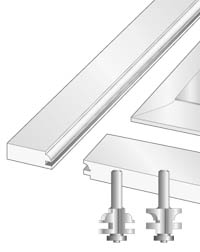
Cope-&-stick joint
cornice (n) — the molded and projecting horizontal piece that crowns architectural structure
counterbore (v) — a method of recessing a screw by drilling a hole larger than the head of the screw and then a smaller hole for the shank and thread
countersink (v) — To cut a cone-shaped recess in a pilot or clearance hole that allows a flat-head screw to seat flush or below the surface; also, the hole itself.

Countersink
cove (n) — a recessed hollow cut into the edge of a board by a router or shaper; also the bit of a cutter that makes a cove
cramp (n, v) — the British term for a device to hold work in process
crosscut (n, v, adj) — A cut perpendicular to the grain of a board.

crosscut
crotch (n) — the part of a tree where there is a V-split in the trunk; this wood is sometimes highly figured and is valued for turning and carving
cup (v) — the action of a board to warp across its width, usually in the opposite direction of the rings
cutting list (n) — a comprehensive list of all the needed parts for a project, including the name of each piece needed, and the dimensions of each piece; sometimes includes a diagram of the boards from which the pieces can be cut to indicate how much lumber must be purchased.
cyanoacrylate glue (n) — the technical generic name for SuperGlue; a type of adhesive that bonds because of polymerization rather than the evaporation of a carrier agent, such as water or a solvent, as with wood glue (aliphatic resin).
D
dado (n, v), dados (pl), dadoing (v) — A three-sided trench cut across the grain of a board.

deadman (n), sliding deadman (n), bench jack (n) — A bench accessory that assists with supporting long boards that are clamped in the workbench’s face vise. The accessory, usually called a deadman, slides on a track parallel to the front edge of the workbench and it is drilled with a series of holes that accept pegs. The pegs can be moved up or down to support boards of various widths. And the deadman can be slid to accomodate different lengths.
dentil (n), dentil-type (adj) — one of a series of small, rectangular blocks forming a moulding, especially under a cornice
dog (n) — an object that holds a workpiece stationary by friction rather than by clamping (commonly referred to as “bench dogs”).
domino (n) – a fastener used to join two surfaces that involves a mortise and loose tenon. Dominoes require a dedicated power tool for the mortises and, most often, mass produced tenons in various sizes for various applications.
dowel (n), doweling (v) — a cylindrical length of wood used for making joints by inserting a length into two corresponding holes and gluing with clamp pressure
doweled joint (n) — Dowels add strength and alignment benefits to what is normally considered a weak joint.

Doweled joint
doweling jig (n) — any number of commercially available devices to assist with placing and drilling of dowel hole.
drawboring, drawbore — The act of pulling the two components of a mortise-and-tenon joint together using a peg and two offset holes. The hole in the mortise is in a slightly different location than the hole through the tenon. When you drive a peg through the two holes it pulls the tenon into the mortise, creating a locked mechanical joint. Drawboring is still widely used in timber framing, though it has fallen out of favor in furniture making.
drawknife (n) — a blade with a handle at each end used for shaving surfaces
dressed (adj) — planed smooth during the finishing process
drill press (n) — a drill head and motor mounted on a vertical column aligned with an adjustable worktable mounted on the same column
dwang (n) − a short horizontal piece of timber fixed between floor/ceiling joists or uprights on a stud partition to stiffen structure.
E
earlywood (n) — the part of a tree’s annual growth ring that grows in the spring; characteristically larger than the latewood part to facilitate the high demand for sap flow in the spring
edge lap (n) — a notch in the edge of a board halfway across its width that forms half of an edge lap joint
edge-glue (v) — gluing together long-grain edges of solid wood, or any edge of plywood
enamel (n) — name given to color finishes with a high varnish content, similar to varnish in handling and protection
end grain (n), end-grain (adj, adv) — the end of a board where the pores are exposed

End Grain
engineer’s square (n) — a precision metal square with a fixed blade for proving 90°
epoxy (n) — a type of adhesive that requires a compound and a catalyst to from the adhesive
etagére (n) — free-standing shelves open on all four sides
F
face (n) — the widest part of the board as measured across the grain
face frame (n) — wood glued together forming one or more usually rectangular openings that cover the front edge of a carcase
face plate (n) — a wood-lathe attachment to support the turning block
FAS (n) — abbreviation for “first and seconds” – lumber grade requiring the worst side of the board be more than 83.3% clear and the board be at least 6″ wide and 8′ long
fascia (n), fascia board (n) — a flat piece used as a moulding; also a horizontal piece covering the joint between the top of a wall and the overhanging eaves
featherboard (n) — A safety device comprising of flexible fingers that hold a workpiece against the fence or table during a cut; often constructed by cutting a number of slots in the end of a board.
ferrule (n) — A metal ring secured around a smaller piece of metal or wood to reinforce it. Ferrules are found where the metal part of a tool intersects its handle. The ferrule prevents the end of the handle from splitting as the handle is knocked onto the chisel’s blade.

file (n) — hardened steel tool in many configurations cut with ridges to abrade material from the workpiece
file card (n) — a stiff brush used to clean files
fillet (n) — either a small square that is part of a moulding or a small rectangular strip
finger joint (n) — Primarily used in commercial applications, the interlocking finger joints reinforce and align panel joints. This is particularly useful when joining boards end-grain to end-grain, as in making continuous floorboards.

Finger joint
fixed-base router (n) — router whose base cannot be moved up or down during operation, but can be adjusted prior to operation (opposite of “plunge router”)
fixture (n) — a device for supporting work during machining
flange (n) — a rib or rim for strength, guiding or attachment to another piece
flat grain (n) — lumber cut tangent to the annual growth rings, it appears highly figured
flitch (n) — one-quarter of a log; also thin, flat-sawn sheet veneer gathered in the order sliced from a log
football (n) — a prolate circle-shaped repaired patch in a plywood face
Forstner bit (n) — A type of bit used to bore clean, flat-bottomed and generally larger holes.
frame and panel (n, adj) — a type of construction that employs an outside frame containing an interior panel
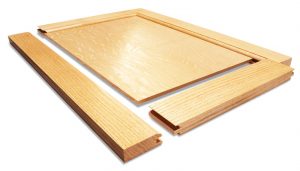
Frame and panel door
fretwork (n) — intricate detail cuts, usually done with a scroll saw or fret saw
G
galoot (n, slang) — a.k.a. Neanderthal: A woodworker who prefers hand tools to power tools, occasionally to the exclusion of power tools from their shops altogether. In general, their media hero is Roy Underhill (sometimes called “St. Roy”), the host of PBS’s “The Woodwright’s Shop.” Neanderthal woodworkers typically use a separate slang lexicon to describe their work. A couple examples: “tailed apprentice” is the term for power tool. “Crispy” is the term for a vintage tool in mint condition.
gateleg table (n) — a type of table with drop leaves that are supported by a leg that swings out; it is sometimes hidden, as one leg is cut in half, half of which is moved to support the leaf
gel stain (n) — An oil-based pigmented stain that is thicker in consistency than traditional oil-based stains. Ranging in consistency from heavy cream to almost peanut butter, gel stains are formulated to work well on vertical surfaces (fewer runs) and on woods that are difficult to stain, such as pine and poplar. The thicker consistency of gel stains is supposed to prevent the stain from absorbing unevenly, which causes ugly blotching.
glue-up (n, v) — The act of assembling parts with glue and clamps.
gouge (n) — a chisel-like turning or carving tool with a curved edge

Gouge
grain (n) — usually refers to texture, porosity or figuring of wood
grain pattern (n) — The visual appearance of the wood grain; types include flat, straight, curly, quilted, rowed, mottled, crotch, cathedral, beeswing and bird’s eye.
groove (n) — A three-sided trench cut with the grain of a board.

groove joint (n) — The groove joint can be used in many ways, but is shown here as a way to lock a thinner cabinet back or a drawer bottom. In each application, the groove captures the thinner piece in place without glue because the thin, solid-wood panel can expand and contract with changes in humidity.

Groove joint
gusset (n) — a triangular block to strengthen the joining of two members assembled at an angle
H
hacksaw (n) — a handsaw that holds a blade at both ends and has a handle at one end, usually used for cutting metals
half pin (n) — in dovetail joints, the two outside pins of a row, named because they are angled only on one side (not because they are half the width of others)
half-blind dovetail joint (n) — A classic drawer joint offering strength and beauty, the half-blind is more difficult to cut than the through dovetail, either by hand or machine. Typically the piece that does not show the joinery is used as the drawer front.

Half blind dovetail
hand plane (n) — a type of cutting device that shaves wood with a blade held in place at a fairly steep angle; there are many kinds (block, bench, bullnose, spokeshave, router, scraper, rabbet)
hand screw (n) — a type of clamp that uses two parallel pieces of wood connected at both ends by threaded rods with handles, it can clamp odd-shaped items
hang (n) – the angle of the handle on a hand saw
hardwood (n) — the wood from any number of flowering, fruit- or nut-bearing trees (see softwood)
haunch (n) — a secondary shoulder cut into the edge of a tenon
haunched mortise-and-tenon joint (n) — Similar to the blind mortise-and-tenon joint, this is used mostly with frame-and-panel doors. The groove for the panel is allowed to run through the end of the stile, simplifying the work. The haunch on the tenon fills the groove.
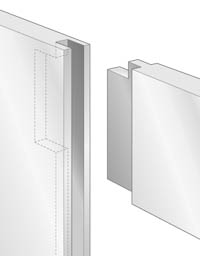
Haunched mortise-&-tenon joint
heartwood (n) — mature wood that forms the spine of a tree
heat treating (n) — The process of heating a piece of steel (typically to 1,450° to 1,500°) to harden it so it will take a keen edge. After the steel has been hardened and quenched it will be brittle and so it must be then tempered at a lower temperature (325°) to toughen the edge for cutting wood.
High-Volume Low-Pressure (adj) — a type of sprayer system generally used for finishing in which a large volume or material is sprayed under low air pressure (abbrev. “HVLP”)
highboy (n) — a tall chest of drawers with a legged base
hold-down (n, adj) — something used to fasten an object in place
hole saw (n) — a type of saw with teeth arranged around the bottom of a cylinder used for cutting larger holes
holidays (n) — areas void of paint or varnish unintentionally skipped during application
hollow-ground (adj) — a concave-cut blade that requires less effort to cut but has a less-durable edge
hone (v) — to sharpen
horsepower (n) — a measurement of work power equivalent to 746 watts; determined by multiplying voltage by amperage; (abbrev. “hp”)
housed (adj) — a situation where one part is enclosed fully or partially by another; a specific family of joints
I
index (n) — a reference to a fence used to position a cut or bit; the act of alignment
infeed (n, v) — the point or act of inserting a piece into a machine, such as a saw, planer or jointer
inlay (n, v) — the material or act of inserting smaller pieces into grooves cut in a workpiece
intarsia (n) — a mosaic or 3-D picture made of wood (cannot be used interchangeable with “marquetry”)
J
jack plane (n) — a medium-sized, general purpose plane
jig (n) — a device that aids in doing repetitive tasks consistently
jigsaw (n) — a power tool using a vertical, reciprocating blade; used for cutting different kinds of materials depending on the type of blade used
joinery (n) — connecting pieces of wood together through a variety of means, including using glue and mechanical fasteners, though generally understood as the use of interlocking or corresponding wooden joints
jointer (n) — the usually-stationary shop machine that makes a uniform, square surface by removing thin layers of material until the whole board is square
jointer plane (n) — a type of plane used to square long edges
jointer/planer (n) — a stationary machine that operates as both a jointer and a planer
K
kerf (n) — The wood removed by a saw blade between the piece you keep and your offcut.
kickback (n), kick back (v) — The action of any number of woodworking machines to throw the workpiece back toward the operator. It usually occurs when wood gets caught between the rip fence and the blade. Splitters – and a dose of common sense – can prevent these.
kiln-dried lumber (n) — lumber that has been dried in a kiln, often to a moisture contend of 6%-12%
knockdown (adj) — a piece that can be disassembled quickly
knot (n) — in lumber, the portion of a branch or limb of a tree that appears on the edge or face of the piece
L
lacquer (n) — a spirit or organic varnish (such as shellac) or a number of synthetic organic coatings that forms film as the carrying solvent evaporates.
laminate (n) — a glued build-up of thin layers of resawn wood or plastics, such as Formica
laminate (v) — adhering one workpiece to another (as a veneer to another surface; constructing solid pieces by gluing together thin strips of wood, usually in a curved form
lap joint (n) — This joint adds strength to a frame corner. The corner lap (also called an end lap) is better than a reinforced (dowels or splines) butt joint, but weaker than mortise-and-tenon joinery. It can be at the corner (called an end lap), in the middle of one piece (called a Tlap) or in the middle of two pieces (called an X-lap).
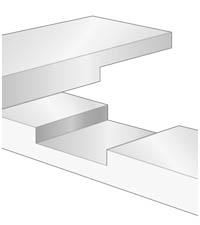
Lap joint
laser printer/cutter (n) — a device featuring a thin, focused, laser beam to cut and etch materials
latewood (n) — the smaller portion of a tree’s annual growth ring that grows through the summer and early fall
latex (n) — water-borne synthetic rubber or plastic used in paints and adhesives
lathe (n) — machine used for turning wood on an axis
left-tilt (adj) — referring to the direction a table saw blade tilts when moved from perpendicular to make an angled cut (see “right-tilt”)
lignum vitae (n) — a type of wood, more commonly called “ironwood”
linkbelt (n) — a generic name for an adjustable V-belt attached to pulleys in stationary machinery
lip (n) — a glued-on or overhanging border of wood
lock-miter joint (n) — An improvement on the standard miter joint that doesn’t require a third piece of wood (a dowel, biscuit or spline). Still offering a tight corner, the lock miter provides greater gluing surface, strength and easier alignment.

Lock-miter joint
locking half-blind rabbet joint (n) — This is a strong joint often used in drawer construction and small boxes. It adds strength and easy alignment for squaring the box.

Locking half-blind rabbet joint
long-grain (adj) — wood cells that grow parallel to the center of the tree; when glued together this grain forms the strongest bond
lumber (n) — the product of the sawmill and planing mill not further manufactured other than by sawing, passing lengthwise through a standard planing machine, crosscutting to length and matching
M
marking gauge (n) — an adjustable device with a steel pin or knife that marks a single layout line parallel to a wood edge
marquetry (n) — a form of inlay in which pieces of veneer are cut into shapes and inserted into another piece of veneer, which is then laminated to another surface (can’t be used interchangeably with “intarsia”)
Medium Density Fiberboard (n) — An engineered panel product (usually abbreviated as MDF) consisting of wood fibers that are glued under heat and pressure. First manufactured in 1924 by the founder of the Masonite Corp. The “medium” in its name refers to the fact that it weighs between 33 and 50 pounds per cubic foot. The less common High Density Fiberboard weighs between 50 and 80 pounds per cubic foot. MDF has no grain structure and no voids. Most variants are susceptible to water damage.
medullary rays (n) — A structure in a tree that stores and delivers food horizontally through the trunk. In some species, such as oak, the medullary rays can be quite large. When the tree is quartersawn, the rays become visible on the face of the board. This feature is sometimes also known as “ray flake.”
mill (n) — cutting a workpiece to its intended size and shape
miter (n) — a surface forming the beveled edge of a joint
miter gauge (n) — a device that slides in a tabletop slot paralleling the blade of a table saw or band saw with a pivoting protractor head and fence to facilitate crosscutting at different angles
miter joint (n) — A traditional box joint that hides edge grain. The miter joint can be tricky to cut perfectly and align during glue-up. When used in a long-grain-to-long-grain application, the strength of the joint is very good, while a short-grain-to-short-grain application offers very little strength.
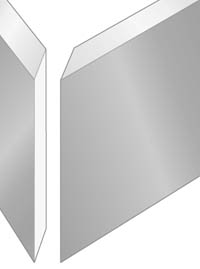
Miter joint
miter saw (n) — a handsaw used with a miter box; a power saw, similar to a circular saw, that cuts miters
mortise (n, v) — a recess cut into a piece to receive a tenon or some kind of hardware, such as a lock or a hinge
moulding (n) — a wood strip (usually with a carved profile) used for ornamentation or finishing
mullion (n) — a center stile that separates panes or panels inside a frame
muntin (n) — a strip that separates panes of glass in a sash
N
nail set (n) — A steel punch-like rod that is used to position the head of a nail flush or below the surface of the wood. They are available in a variety of diameters and with a number of tips for certain jobs. They are essential tools for any fine work being done with a hammer. While modern pneumatic nail guns automatically set the nail below the surface of the wood, a nail set is still handy because occasionally the nail gun fails.
natural finish (n) — a transparent finish that does not seriously alter the original color or grain of the wood
neanderthal n, slang — a.k.a. galoot: A woodworker who prefers hand tools to power tools, occasionally to the exclusion of power tools from their shops altogether. In general, their media hero is Roy Underhill (sometimes called “St. Roy”), the host of PBS’s “The Woodwright’s Shop.” Neanderthal woodworkers typically use a separate slang lexicon to describe their work. A couple examples: “tailed apprentice” is the term for power tool. “Crispy” is the term for a vintage tool in mint condition.
nickel metal hydride (adj) — a type of rechargeable battery (abbrev. “NiMH”)
nickel-cadmium (adj) — a type of rechargeable battery (abbrev. “Ni-Cad”)
normite (n, slang) — A term used primarily by Neanderthals to describe woodworkers who use only power tools. “Normite” refers to Norm Abram, the host of the popular PBS program “The New Yankee Workshop.” Abram is know for his affection for power tools, though Neanderthals have noted (and secretly been thrilled by) later episodes that show Abram using hand tools in his work.
notch (n) — a dado cut into the edge of wood that is part of an edge lap joint if it extends halfway into the wood
O
offcut (n, adj) — A waste piece of lumber.
ogee (n) — an S-shaped profile
oil stain (n) — a stain formed by mixing oil-soluble dyes in an oil or oleoresinous base
on center (adj) — setting two points so they are equidistant from a center point; also used when spacing studs or slates (abbrev “O.C.”)
open-grained (adj) — wood having large pores; coarse-textured wood
open-slot mortise (n) — a mortise made in the end of a board used in a bridle joint
orbital sander (n) — a type of finishing sander where the motor’s energy is converted to minute circles, which causes sandpaper to abrade a surface
outfeed (n, v, adj) — The point where the workpiece exits a machine
P
panel (n) — A large wood surface, sometimes made out of several boards glued edge-to-edge.

Panel
particleboard (n) — Similar to Medium Density Fiberboard (MDF), this engineered product is made using waste wood and adhesive pressed under heat and pressure. The bits of wood used in particleboard are larger than the fine fiber in MDF, making the panel less consistent. Like MDF, particleboard is vulnerable to moisture.
phenolic, phenolic resin (n) — a resin or plastic used in coatings or adhesives that becomes permanently rigid when heated or cured
pilot hole (n) — A small hole drilled in your work that is intended to guide a fastener. The hole will ensure the fastener is driven in the desired direction and clears some waste wood to prevent your work from splitting when the fastener is driven in place.
pilot-bearing guide (n) — a free-moving bearing attached to a router bit that allows the bit to follow the shape of an existing edge
pin (n) — the part of a dovetail joint whose dovetail shape is on the end of the board and fits between the tails; also a screw or dowel used to reinforce a joint
pin knot (n) — a very small knot
pipe clamp (n) — one end of the clamp jaws is attached to the head of standard metal pipe or bar stock while the foot is cam-cleated or slipped into various slots (also called bar clamp)
plain-saw (v), plain-sawn (adj) — wood cut tangential to the annual growth rings (also called flat-sawn)
plane (n), planing (v) — a hand tool used to carve thin slices from a board to straighten or square a surface or edge
planer (n) — a power tool that planes lumber
pocket (n) — any hole or socket of various shapes that fit mated joint parts
pocket hole (n) − popular alternative to doweled, mortise & tenon or other joining techniques. A jig creates a pocket hole with a special step bit that leaves a pilot hole as well as a shoulder for stopping the pocket screw at a pre-determined depth.

Pocket hole
points per inch (adj) – a method by which saw blades are classified (abbrev. “ppi”), based on the number of tooth points in a 1″ span
polyurethane (n) — any of a variety of polymers used in rigid (as in Plexiglas), foam (as in Styrofoam or foam rubber) or resin (as in finishing products) forms
polyvinyl (adj) — relating to a polymerized vinyl compound, such as plastics or resins
polyvinyl acetate glue (n) — white glue (abbrev “PVA”)
predrill (v) — To drill a hole before driving a nail. This decreases the chance of splitting the wood.
press fit (n) — a description of two mating parts, as in a joint, where parts fit snugly without requiring force to mate
push stick (n) — A hand-held safety device used for pushing wood past a cutter to keep the hands away from the blade.
Q
quarter-sawn (v) – A cut of lumber where the growth rings are perpendicular to the face of the board
R
rabbet (n, v) — A two-sided trench cut on the edge of a board.

rabbet joint (n) — A very basic joint for box building, the rabbet joint is an improvement over the butt joint for strength. It adds extra gluing surface and protects against racking.

Rabbet joint
rabbet plane (n) — an edge plane for producing a rabbet
rabbet-and-dado joint (n) — By locking the rabbet in a dado, the strength and protection against racking found in a rabbet joint are improved.

Rabbet-&-dado joint
racking force (n) — In woodworking, this term typically refers to a twisting force on an assembly, such as a door, cabinet or chair. Racking forces are those that press on your projects at angles other than 90°.
radial-arm saw (n) — a power tool that consists of a motor and blade that are suspended above the table from an arm that pivots at the rear and upon which the motor slides
rail (n) — The horizontal member of any frame, such as a door, window or face frame.

Rail
rail-and-stile bit (n) — a router bit or matched pair of bits used to form mating edges of door rails and stiles
raised-panel door (n) — a frame-and-panel construction door of which the panel has a raised profile
rake (n) – the angle of the cutting face of a saw blade tooth
resaw (v) — to cut a board along its length and width to yield thinner boards
reveal (v) — sides of surrounding frame exposed by a panel or member set in from the outermost plane
rift-cut (adj) — wood, including veneer, cut at 45° to the growth rings (also “rift-sawn”)
right-tilt (adj) — referring to the direction a table saw blade tilts when moved away from perpendicular to the saw table (see “left-tilt”)
rip cut (n, v) — A cut parallel to the grain of a board.
rip fence (n) — The movable guide on a table saw that’s parallel to the blade against which boards are referenced when making a rip cut.
root (n) — the portion of a screw length below the head that has threads on it
rotary-cut, rotary-peeled (adj) — lumber that is cut & not surfaced
rough-cut (v, adj) — to cut to an approximate length that is somewhat longer than an exact cut
roundover (n, adj), round over (v) — a bit or cutter which cuts the corner off the edge of a board, giving it a rounded edge
router table (n) — a table to which a router is mounted inverted with the bit coming up through the surface; the workpiece is moved against the stationary bit
ryoba saw (n) — a Japanese saw; a two-edged saw
S
scales (n) — The wooden handle on a knife.
scribe (v) — to transfer lines to a replacement member or pattern using dividers or a circle compass
shank (n) — the shaft of a bit or cutter that is gripped in a tool by a chuck or a collet
shear forces (n) — In woodworking, this term typically refers to the effect of gravity and the weight of objects on cabinet parts, particularly shelving. The force comes from one direction and is typically parallel to the sides of a case piece.
sheet good (n) — Man-made wood product, such as plywood, particleboard or medium-density fiberboard (MDF).
shellac (n, v) — a type of finish derived from an organic secretion or the lac bug; found in liquid, granule and flake
shim (n, v) — a thick wedge of wood used to fill a gap or make a surface level
shiplap joint (n) — Shiplaps are traditionally used in solid-wood cabinet backs. The overlapping edges hide any seasonal wood movement.

Shiplap joint
short grain (n) — long-grain whose fibers are cut across and left so short that the material becomes fragile and won’t hold together
shoulder (n) — the perpendicular face of a step cut, such as a rabbet, which bears against a mating joint part to stabilize the joint
skew chisel (n) — a carving or turning chisel which has a cutting edge that is not perpendicular to the sides of the chisel; it can angle left or right
sliding bevel (n) — a tool with a changeable angle between its blade and beam
sliding dovetail joint (n) — This joint offers great strength and rigidity for box work, especially drawers and case pieces. In drawers, the sliding dovetail typically will join the drawer sides to the drawer front and leaves space for installing drawer slides. In a case piece, the sliding dovetail joins shelves to the case sides.
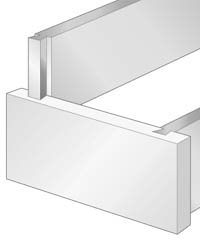
Sliding dovetail joint
snipe (n) — the action of a planer or jointer to pinch and mar the end of a board
softwood (n) — the wood of any coniferous tree
spade bit (n) — flat woodworking bit for high-speed drilling of larger diameter holes; the width can be ground to nonstandard diameter
spall (v) — to break up or reduce by or as if by chipping with a hammer; to break off chips or scales; exfoliate
Speed Square (proper n) — A small triangular-shaped layout tool that combines aspects of try, miter and framing squares. The tool has a lip on one side to allow it to hook on your work. Typically used in home construction, but is also common among woodworkers.
spline (n) — a narrow strip of wood that is glued in corresponding grooves to join pieces of wood
spline joint (n) — Adding a spline helps align the pieces during glue-up. The spline requires milling another piece of wood, instead of just buying biscuits, but it helps align the pieces along the entire edge.
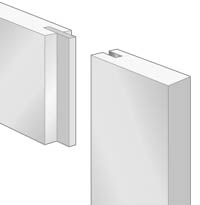
Spline joint
split (n) — a situation where the wood material has broken along the grain
spokeshave (n) — a type of plane or drawknife that is drawn by two handles and planes concave or convex
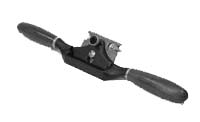
Spokeshave
stile (n) — The vertical member of any frame, such as a door, window or face frame.
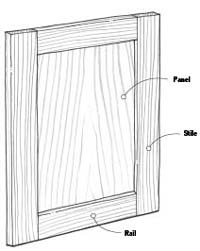
Style
stopped joint (n) — This cross-grain grooved joint offers good strength, surpassed only by interlocking joints such as a sliding dovetail joint. Because the dado is stopped and the shelf notched, the joinery remains hidden when assembled. Typically used to join shelves to the sides of a case piece, this joint is ideal for cabinets without face frames.

Stopped joint
stopped sliding dovetail joint (n) — An improved version of the stopped dado joint for box or cabinet construction, the stopped sliding dovetail joint locks the two pieces together, but it can be difficult to create.

Stopped sliding dovetail
story stick (n) — a small, flat piece of wood that is marked with specific repeating measurements for a project
straight bit (n) — a router bit with a straight cutting edge
straight-grained (adj) — the grain pattern that results when annual rings are perpendicular to the face and run parallel to the edge.
straightedge (n), straight-edged (adj) — any of a variety of measuring devices that have a square, straight side; may or may not be marked with a measuring system
stretcher (n) – any horizontal support member on an item of furniture (table, chair, workbench) that ties to and offers support to vertical elements (such as legs)
strop (n) — a device, usually leather, used to hone the edge of a blade
surface (v) — to plane or make smooth
T
table saw (n) — a type of stationary arbor-driven circular saw that is set below a table upon which the workpiece is cut
tail (n) — the part of a dovetail joint whose shape is cut into the face of a board and which fits around the pins
tambour (n) — a type of sliding door that employs a number of narrow strips meeting in a loose tongue and groove and are attached to a piece of cloth and set in a track
taper (n) — a cut with the grain that gradually angles along the edge of the board instead of running parallel to it
tear-out (n), tear out (v) — The chipping of an edge along the kerf.
teeth per inch (adj) — a method by which saw blades are classified (abbrev. “tpi”), based on the number of full teeth in a 1″ span
tenon (n, v) — the rabbeted edge that is inserted into a matching recess, called a mortise
tension (n) — force on the joint or wood that pulls it in opposite directions
track saw (n) – a circular saw that runs on an extruded track for breaking down sheet goods
through dovetail joint (n) — Similar to the half-blind dovetail joint, but much easier to make. It offers great strength and visible joinery on both faces of the corner. It typically appears in case construction to join the top, bottom and sides. It also is commonly found at the back of drawer boxes, joining the drawer sides with the back.
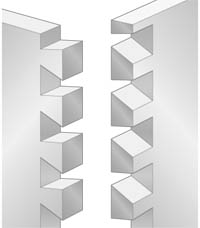
Through dovetail joint
through joint (n) — Similar in strength to the stopped dado joint, this dado continues through both sides of the side piece. This is easier to make, but it leaves the joinery visible. It is typically used to join shelves to the sides of a carcase, especially when the cabinet will be fitted with a face frame that will conceal the joinery.
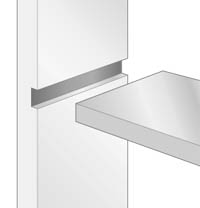
Through joint
through mortise-and-tenon joint (n) — The through tenon is seen on the opposite side of the mortised piece. It is a simple way to not have to worry about gauging the accurate depth of the mortise, because the tenon is cut flush after assembly.

Through mortise-and-tenon joint
toenail (v) — the act of driving a nail at an angle through a board to attach it to another surface (done at an angle because of a tight space where a hammer cannot be used effectively, or to attach a piece perpendicular to another piece)
tongue-and-groove joint (n) — Essentially a mortise-and-tenon joint cut along the length of two boards, this joint can add some strength to an already strong long-grain edge joint, but is most useful when used without glue. This joint allows the boards to move with changes in humidity, but still keeps the surfaces evenly aligned.

Tongue-and-groove joint
totally enclosed fan-cooled (adj) — a type of motor (abbrev. “TEFC”)
truing (v) — the act of making true, as in square, flat, concentric or balanced; or to restore to an original shape
trunnion (n) — a pin or pivot on which something can be rotated or tilted
turnery, turning (n) — refers to work done on a lathe
twist drill (n) — a drill bit comprising a cylindrical shank with helical flute to carry away the material, its end is shaped in a conical angle that forms cutting edges
U
V
varnish (n, v) — a coating that provides a hard, usually clear, finish
veneer (n, v) — a thin sheet of wood used in a variety of applications, including marquetry, lamination, covering lesser cuts of wood, constructing plywood
vernier caliper (n) — a measuring device that has a main scale with a fixed jaw and a sliding jaw with an attached auxiliary scale
W
wainscotting (n, v) — to line with or as if with boards or paneling; as a noun referring to those boards
waney-edged (adj) — has bark on it
wedge (n) — a slice of wood glued into a kerf in the end of a through-tenon
wedged mortise-and-tenon joint (n) — A stronger version of the through mortise-and-tenon joint, the wedges spread the tenon in the mortise, locking the joint tightly in place. As a secondary advantage, the wedged tenon is a nice decorative element.

Wedged mortise-and-tenon joint
wenge (n) — a type of wood
winding sticks (n) — two straight, mated sticks that are placed on the edges of opposite ends of a bard and sighted across to prove the flatness of the lumber
wood movement (n) — The tendency of wood to expand and contract across the grain as its moisture content fluctuates in response to changes in relative humidity.
woodworker (n) — someone who works with wood; do not use interchangeably with “carpenter,” “cabinetmaker” or “furniture maker”
woodworking (n, v) — any activity that involves working with wood – particularly building items with wood – but not home or other building construction
X
Y
Z
z-clip (n) a tabletop fastener that allows for wood movement
Here are some supplies and tools we find essential in our everyday work around the shop. We may receive a commission from sales referred by our links; however, we have carefully selected these products for their usefulness and quality.










